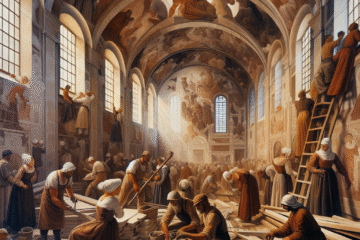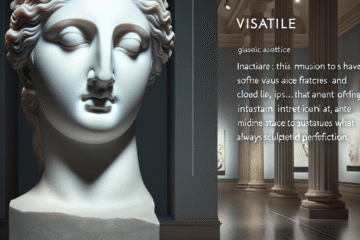I. Introduction
Prehistoric art is the earliest form of artistic expression created by our human ancestors, and it has been a subject of fascination for scholars, archaeologists, and art lovers for centuries. These artworks, ranging from cave paintings to figurines and sculptures, were created by ancient humans using basic materials such as stone, bone, and pigment. While the artworks are primitive in comparison to contemporary art, they remain significant in their historical and cultural importance.
The study of prehistoric art is vital to our understanding of the origins of human creativity. It provides insights into the ways in which early humans expressed themselves, their beliefs, and their experiences in a world that was vastly different from the world we know today. By analyzing prehistoric art, we can learn about the social, economic, and cultural practices of ancient societies, as well as the emotional and spiritual lives of our ancestors.
This article aims to explore the topic of prehistoric art and its significance in understanding the origins of human creativity. The article will be structured as follows:
In section II, we will discuss the beginnings of prehistoric art, including the earliest known examples of prehistoric art and the materials and techniques used to create them. In section III, we will examine the purpose of prehistoric art, including the different theories about why prehistoric people created art and what it reveals about their societies. In section IV, we will explore the evolution of prehistoric art, including how it changed over time and across different regions. In section V, we will discuss the significance of prehistoric art in understanding the origins of human creativity, and how it paved the way for future artistic developments. Finally, in section VI, we will conclude the article by summarizing the main points and highlighting the potential for future discoveries and research in the field of prehistoric art.
Overall, this article aims to provide a comprehensive overview of prehistoric art and its significance in understanding the origins of human creativity. Through the exploration of different aspects of prehistoric art, we hope to gain a deeper appreciation for our human ancestors and the artistic legacy they left behind.
II. The Beginnings of Prehistoric Art
The earliest examples of prehistoric art date back to the Paleolithic period, which began around 2.6 million years ago and ended around 10,000 BCE. During this time, our human ancestors created a range of artworks, including figurines, sculptures, and cave paintings. These artworks provide a fascinating glimpse into the cultural and historical context in which they were created, and the materials and techniques used to make them.
One of the most well-known examples of prehistoric art is the Venus figurines, which are a collection of small, carved sculptures depicting female figures. These figurines, which date back to between 35,000 and 10,000 BCE, were created using a variety of materials, including stone, ivory, and clay. They are characterized by their exaggerated feminine features, such as large breasts, hips, and buttocks, and have been interpreted as representations of fertility, goddesses, or ancestors.
Another famous example of prehistoric art is the cave paintings of Lascaux and Altamira, which date back to around 15,000 BCE. These cave paintings were discovered in the 19th and 20th centuries and depict a range of animals, including horses, deer, and bison, as well as human figures and abstract shapes. The paintings were created using natural pigments, such as iron oxide and charcoal, and were applied to the cave walls using various techniques, including blowing the pigment through reeds and using fingers or brushes to apply the pigment.
The materials and techniques used to create prehistoric art varied depending on the region and time period. In addition to stone, ivory, and clay, prehistoric artists also used materials such as bone, antler, and shell. The tools used to create these artworks were often made from stone, bone, or wood, and included chisels, knives, and awls.
The cultural and historical context in which prehistoric art was created is also an important factor to consider. For example, some artworks, such as the Venus figurines, have been interpreted as having religious or spiritual significance, while others, such as the cave paintings, have been interpreted as a form of hunting magic or a means of documenting the natural world.
In conclusion, the beginnings of prehistoric art are marked by a range of fascinating and diverse artworks, including the Venus figurines and cave paintings of Lascaux and Altamira. These artworks were created using a range of materials and techniques and reflect the cultural and historical context in which they were made. By studying the earliest examples of prehistoric art, we can gain a deeper understanding of the origins of human creativity and the role of art in early societies.
III. The Purpose of Prehistoric Art
The purpose of prehistoric art has been a subject of much debate among scholars and archaeologists. While the exact motivations behind the creation of these artworks are not fully understood, there are several theories about why prehistoric people created art. These theories include religious or shamanic purposes, as a means of communication or storytelling, and as a way of documenting their surroundings.
One of the most widely accepted theories about the purpose of prehistoric art is that it was created for religious or shamanic purposes. Many prehistoric artworks, such as the Venus figurines, have been interpreted as having religious significance, perhaps representing fertility or goddesses. Similarly, some cave paintings have been interpreted as depicting shamanic rituals or other religious ceremonies. These artworks may have been created as part of religious or spiritual practices, or as a means of communicating with the divine.
Another theory about the purpose of prehistoric art is that it was a means of communication or storytelling. Some prehistoric artworks, such as the cave paintings of Lascaux and Altamira, depict animals and humans in various scenes that may have had a narrative or symbolic meaning. These artworks may have been used to convey important information, such as the location of a food source or a hunting technique, or as a means of passing down stories and cultural traditions from one generation to the next.
A third theory about the purpose of prehistoric art is that it was a way of documenting the natural world. Many prehistoric artworks, such as cave paintings and carvings, depict animals, plants, and landscapes in great detail. These artworks may have been created as a way of recording the natural world, or as a means of documenting the daily life and surroundings of prehistoric societies.
Prehistoric art provides valuable insights into the social, economic, and cultural practices of ancient societies. For example, the materials and techniques used to create prehistoric art can tell us about the technological and artistic capabilities of prehistoric people, as well as their access to resources. Similarly, the subject matter of prehistoric art can tell us about the daily life, beliefs, and experiences of prehistoric societies, such as their relationship with animals and the natural world, their religious and spiritual practices, and their social and cultural practices.
In conclusion, the purpose of prehistoric art is multifaceted and complex, and likely varied depending on the time period and region in which the artworks were created. By examining different theories about the purpose of prehistoric art and studying the artworks themselves, we can gain a deeper understanding of the social, economic, and cultural practices of ancient societies. Prehistoric art provides us with a fascinating glimpse into the past, and helps us to appreciate the artistic legacy of our human ancestors.
IV. The Evolution of Prehistoric Art
Prehistoric art is an incredibly diverse field that spans many different time periods and regions. As such, it has evolved and changed in a number of ways over time. This article will explore the evolution of prehistoric art by discussing the development of new materials and techniques, changes in subject matter, and the influence of outside factors such as climate and migration.
One of the most significant developments in prehistoric art was the development of new materials and techniques. Early prehistoric art was often created using basic materials such as stone, bone, and pigment. However, as prehistoric societies became more advanced, so too did their artistic techniques. For example, in the Neolithic period, which began around 10,000 BCE, prehistoric artists began to use new materials such as copper and bronze, which allowed them to create more intricate and detailed artworks. They also developed new techniques such as pottery-making and weaving, which allowed them to create functional as well as decorative objects.
Another way in which prehistoric art evolved was through changes in subject matter. Early prehistoric art often focused on naturalistic representations of animals, plants, and landscapes. However, as prehistoric societies became more complex, so too did their artistic subjects. For example, in the Bronze Age, which began around 3,000 BCE, prehistoric artists began to depict more human subjects, such as warriors and royalty. They also began to create more abstract and symbolic artworks, such as Celtic knotwork and other geometric designs.
The evolution of prehistoric art was also influenced by outside factors such as climate and migration. For example, during the Ice Age, which began around 2.6 million years ago and ended around 10,000 BCE, prehistoric societies were forced to adapt to cold and inhospitable environments. This led to the development of new artistic techniques, such as the creation of small, portable objects that could be carried from place to place. Similarly, the migration of prehistoric societies to new regions often led to the adoption of new artistic styles and techniques.
The diversity of prehistoric art across different regions and time periods is striking. For example, the prehistoric art of Africa is characterized by intricate designs and patterns, often created using a technique known as rock engraving. In Asia, prehistoric artists created delicate figurines and pottery, often decorated with intricate designs and patterns. In Europe, prehistoric art is characterized by the cave paintings of Lascaux and Altamira, as well as the intricate metalwork of the Bronze Age.
In conclusion, the evolution of prehistoric art was a complex and multifaceted process that spanned many different time periods and regions. As prehistoric societies became more complex and sophisticated, so too did their artistic techniques and subject matter. The influence of outside factors such as climate and migration also played a significant role in the evolution of prehistoric art. By examining the diversity of prehistoric art across different regions and time periods, we can gain a deeper appreciation for the artistic legacy of our human ancestors.
V. Prehistoric Art and Human Creativity
Prehistoric art provides a fascinating glimpse into the origins of human creativity and the ways in which our ancient ancestors expressed themselves. Prehistoric art is evidence of the innate human capacity for creativity and imagination, and it paved the way for future artistic developments. The study of prehistoric art can also provide insights into the origins of human thought, emotion, and expression.
One of the most significant aspects of prehistoric art is its evidence of the innate human capacity for creativity and imagination. The fact that prehistoric people created artworks using only basic materials and tools is a testament to the human drive to create and express oneself. These artworks demonstrate a remarkable level of skill and attention to detail, and they have stood the test of time as enduring examples of human creativity.
Prehistoric art also paved the way for future artistic developments. The techniques and materials used to create prehistoric art were often adapted and refined by later societies. For example, the use of natural pigments in cave paintings laid the groundwork for the development of painting as an art form. Similarly, the development of new materials and techniques, such as the creation of pottery and metalworking, had a significant impact on the development of art in later periods.
The study of prehistoric art can also provide valuable insights into the origins of human thought, emotion, and expression. For example, the subject matter of prehistoric art can tell us about the relationship between prehistoric societies and the natural world, as well as their religious and spiritual beliefs. The use of abstract and symbolic motifs in prehistoric art can also provide insights into the ways in which prehistoric people understood the world around them.
Prehistoric art can also shed light on the emotional and expressive lives of prehistoric people. The creation of artworks such as the Venus figurines, which depict exaggerated feminine features, suggests that prehistoric people had a complex and nuanced understanding of gender and sexuality. Similarly, the depiction of human and animal figures in cave paintings may have served as a means of expressing emotions such as fear, awe, and wonder.
In conclusion, prehistoric art is evidence of the innate human capacity for creativity and imagination, and it paved the way for future artistic developments. The study of prehistoric art can provide valuable insights into the origins of human thought, emotion, and expression. By examining prehistoric art, we can gain a deeper appreciation for the artistic legacy of our human ancestors and the ways in which they expressed themselves in a world that was vastly different from our own.
VI. Conclusion
In conclusion, the study of prehistoric art provides valuable insights into the origins of human creativity and expression. From the earliest known examples of prehistoric art, such as the Venus figurines and cave paintings of Lascaux and Altamira, to the diverse range of artworks created by prehistoric societies across different regions and time periods, prehistoric art tells a fascinating story of human ingenuity and imagination.
The beginnings of prehistoric art are marked by a range of diverse artworks, created using materials and techniques that were often adapted and refined by later societies. The purpose of prehistoric art is multifaceted, including religious or shamanic purposes, as a means of communication or storytelling, and as a way of documenting the natural world. Prehistoric art also provides valuable insights into the social, economic, and cultural practices of ancient societies, and sheds light on the emotional and expressive lives of our human ancestors.
Looking to the future, there is great potential for new discoveries and research in the field of prehistoric art. As new archaeological sites are uncovered and new technologies and methods are developed, we may be able to gain a deeper understanding of the origins of human creativity and expression. Advances in fields such as DNA analysis and radiocarbon dating may also help us to better understand the cultural and historical context in which prehistoric art was created.
In conclusion, prehistoric art is a testament to the innate human capacity for creativity and imagination, and it remains a vital field of study for scholars, archaeologists, and art lovers alike. By examining prehistoric art, we can gain a deeper appreciation for the artistic legacy of our human ancestors and the ways in which they expressed themselves in a world that was vastly different from our own. The study of prehistoric art has the potential to unlock new insights into the origins of human creativity and expression, and we can only look forward to what future discoveries and research will reveal.


